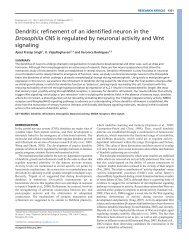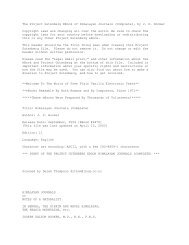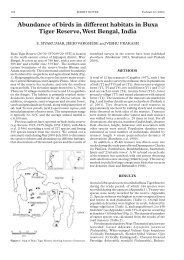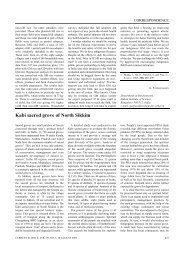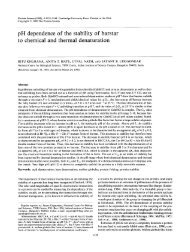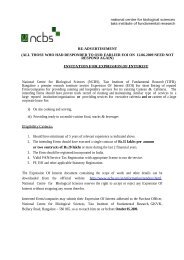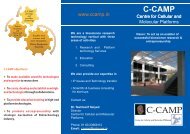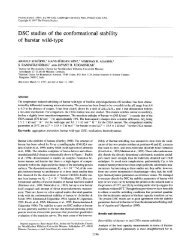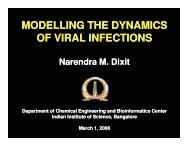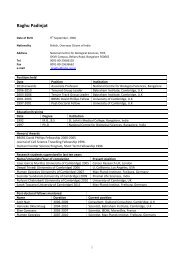Muscles in the Drosophila second thoracic segment are patterned ...
Muscles in the Drosophila second thoracic segment are patterned ...
Muscles in the Drosophila second thoracic segment are patterned ...
You also want an ePaper? Increase the reach of your titles
YUMPU automatically turns print PDFs into web optimized ePapers that Google loves.
Research Paper Homeotic gene function <strong>in</strong> <strong>Drosophila</strong> <strong>thoracic</strong> muscle development Roy et al. 223<br />
Figure 1<br />
Figure 2<br />
(a)<br />
T2<br />
T3<br />
Lateral<br />
muscles<br />
Ventral<br />
muscles<br />
(b) (c) (d)<br />
(e)<br />
(f)<br />
Antp is expressed <strong>in</strong> <strong>the</strong> T3 mesoderm, but not <strong>in</strong> T2 mesoderm dur<strong>in</strong>g<br />
embryogenesis. (a) Stage 12 embryo show<strong>in</strong>g expression of Antp <strong>in</strong><br />
<strong>the</strong> mesodermal cells of T3 (posterior-most arrow). Expression is<br />
absent from T1 and T2 mesoderm (anterior-most and middle arrow,<br />
respectively). (b) Stage 13 embryo show<strong>in</strong>g Antp expression <strong>in</strong> <strong>the</strong><br />
develop<strong>in</strong>g somatic muscles <strong>in</strong> T3 (vertical arrow). Expression <strong>in</strong> <strong>the</strong><br />
central nervous system of T1 and T2 <strong>segment</strong>s is <strong>in</strong>dicated by<br />
horizontal arrows. In (a), anterior is to <strong>the</strong> left and dorsal is top; <strong>in</strong> (b),<br />
anterior is top.<br />
Embryos that <strong>are</strong> homozygous mutant for a null allele of<br />
Antp, Antp w10 , exhibited severe disorganization of <strong>the</strong><br />
muscle pattern <strong>in</strong> T2 and T3 (Fig. 2b,c). Because Antp is<br />
not expressed <strong>in</strong> T2 mesoderm, we reasoned that <strong>the</strong><br />
muscle defects seen <strong>in</strong> T2 were due to <strong>in</strong>direct effects on<br />
<strong>the</strong> mesoderm of <strong>the</strong> absence of Antp function <strong>in</strong> <strong>the</strong> overly<strong>in</strong>g<br />
ectoderm. Fur<strong>the</strong>rmore, because Antp is expressed<br />
<strong>in</strong> T3 mesoderm and ectoderm [8], and has been shown to<br />
be required <strong>in</strong> T3 ectoderm [9,10], <strong>the</strong> effects on T3<br />
muscle pattern <strong>in</strong> Antp w10 embryos must have been caused<br />
by a comb<strong>in</strong>ation of <strong>the</strong> autonomous requirement of Antp<br />
<strong>in</strong> <strong>the</strong> mesoderm and <strong>the</strong> <strong>in</strong>ductive <strong>in</strong>fluences of Antp<br />
from <strong>the</strong> ectoderm. In order to test this reason<strong>in</strong>g, we<br />
selectively removed Antp function from <strong>the</strong> mesoderm,<br />
us<strong>in</strong>g mosaic embryos which expressed wild-type Antp <strong>in</strong><br />
<strong>the</strong> ectoderm only; for <strong>the</strong>se experiments, we used an<br />
ectoderm-specific GAL4 l<strong>in</strong>e, e22c [11], and <strong>the</strong> UAS-Antp<br />
transgene [12], <strong>in</strong> an o<strong>the</strong>rwise Antp null genetic background<br />
(Fig. 2d). We were able to dist<strong>in</strong>guish Antp mutant<br />
embryos by <strong>the</strong> absence of <strong>the</strong> first midgut constriction<br />
(Fig. 2e,f). In <strong>the</strong> presence of ectodermal Antp expression<br />
<strong>in</strong> such embryos, we observed that <strong>the</strong> muscle pattern <strong>in</strong><br />
T2 was completely rescued (Fig. 2d), <strong>in</strong>dicat<strong>in</strong>g that<br />
muscle pattern<strong>in</strong>g <strong>in</strong> this <strong>segment</strong> has a non-autonomous<br />
requirement for Antp.<br />
Analysis of T2- and T3-specific muscle patterns <strong>in</strong> loss-of-function Antp<br />
mutants and <strong>in</strong> mosaic embryos that have Antp function selectively<br />
removed from <strong>the</strong> mesoderm. (a) Schematic representation of wild-type<br />
muscle patterns <strong>in</strong> T2 and T3 <strong>segment</strong>s. The four lateral muscles<br />
(lateral transverse 1–4) <strong>are</strong> represented <strong>in</strong> red rectangles and <strong>the</strong>ir<br />
patterns <strong>are</strong> similar <strong>in</strong> both <strong>segment</strong>s; <strong>the</strong> ventral muscle patterns <strong>are</strong><br />
illustrated below <strong>the</strong> lateral muscles. We analyzed <strong>the</strong> phenotypes of<br />
<strong>the</strong> lateral muscles <strong>in</strong> Antp mutants and <strong>in</strong> mosaic embryos with Antp<br />
function selectively removed from <strong>the</strong> mesoderm, because <strong>the</strong><br />
phenotypic changes <strong>in</strong> <strong>the</strong>se <strong>are</strong> strik<strong>in</strong>g and least susceptible to mis<strong>in</strong>terpretation.<br />
The schematic of muscle patterns has been adapted<br />
from Bate [2]. (b) Wild-type pattern of lateral muscles <strong>in</strong> T2 (left arrow)<br />
and T3 (right arrow) <strong>in</strong> a stage 16 embryo. (c) A representative example<br />
of disrupted muscle pattern <strong>in</strong> T2 and T3 (asterisks) <strong>in</strong> embryos<br />
homozygous for a null allele of Antp (Antp w10 ). Although we have<br />
highlighted only <strong>the</strong> lateral muscles, <strong>the</strong>se embryos exhibit drastic<br />
disorganization of almost all muscle fibres <strong>in</strong> T2 and T3. (d) Rescued<br />
lateral muscles <strong>in</strong> T2 of an Antp w10 embryo (left arrow) <strong>in</strong> which Antp<br />
function was provided only <strong>in</strong> <strong>the</strong> ectoderm us<strong>in</strong>g <strong>the</strong> e22c-GAL4 driver<br />
and <strong>the</strong> UAS-Antp transgene <strong>in</strong> an o<strong>the</strong>rwise Antp null background<br />
(n = 25 mutant embryos were identified, half of which were expected to<br />
carry both <strong>the</strong> e22c-GAL4 transgene and <strong>the</strong> UAS-Antp transgene;<br />
transformation of mutant phenotypes to wild-type was observed <strong>in</strong><br />
n = 11 animals). Comp<strong>are</strong> <strong>the</strong> rescued lateral muscles <strong>in</strong> this figure with<br />
<strong>the</strong> wild-type pattern (left arrow, Fig. 2b) and mutant pattern <strong>in</strong> Antp null<br />
embryos (left asterisk, Fig. 2c). Note also <strong>the</strong> rescue of <strong>the</strong> pattern of T3<br />
lateral muscles <strong>in</strong> <strong>the</strong>se embryos (right arrow). Comp<strong>are</strong> this rescued<br />
pattern with <strong>the</strong> wild-type T3 pattern (right arrow, Fig. 2b) and mutant<br />
pattern (right asterisk, Fig. 2c). In <strong>the</strong>se embryos, we also observed<br />
rescue of o<strong>the</strong>r muscle fibres <strong>in</strong> both T2 and T3. Antp w10 homozygous<br />
mutant embryos can be easily identified on <strong>the</strong> basis of midgut<br />
constriction patterns [23,24]. See text and <strong>the</strong> Materials and methods<br />
section for details. (e) Pattern of midgut constrictions <strong>in</strong> stage 16 wildtype<br />
embryo (arrowheads). (f) Pattern of midgut constrictions <strong>in</strong> a stage<br />
16 Antp w10 embryo (arrowheads). Note <strong>the</strong> absence of <strong>the</strong> first midgut<br />
constriction. In (a–f), anterior is left.



